全英版小学英语教案【三篇】
- 格式:pdf
- 大小:11.14 KB
- 文档页数:8
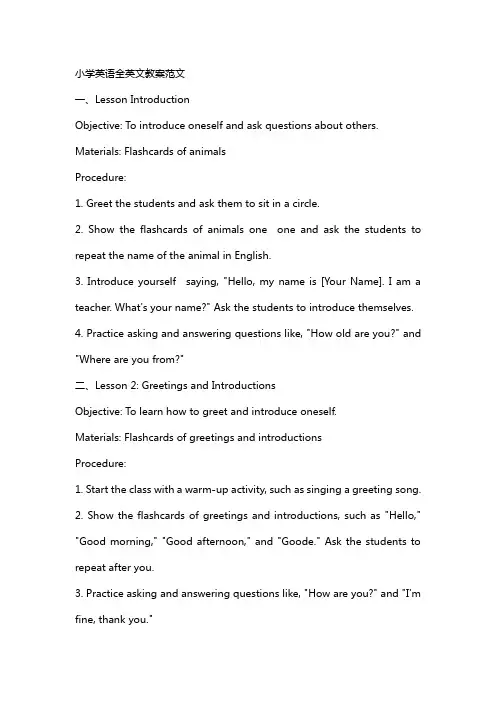
小学英语全英文教案范文一、Lesson IntroductionObjective: To introduce oneself and ask questions about others. Materials: Flashcards of animalsProcedure:1. Greet the students and ask them to sit in a circle.2. Show the flashcards of animals one one and ask the students to repeat the name of the animal in English.3. Introduce yourself saying, "Hello, my name is [Your Name]. I am a teacher. What's your name?" Ask the students to introduce themselves.4. Practice asking and answering questions like, "How old are you?" and "Where are you from?"二、Lesson 2: Greetings and IntroductionsObjective: To learn how to greet and introduce oneself.Materials: Flashcards of greetings and introductionsProcedure:1. Start the class with a warm-up activity, such as singing a greeting song.2. Show the flashcards of greetings and introductions, such as "Hello," "Good morning," "Good afternoon," and "Goode." Ask the students to repeat after you.3. Practice asking and answering questions like, "How are you?" and "I'm fine, thank you."4. Introduce a new student to the class and ask the students to greet and introduce themselves.三、Lesson 3: ColorsObjective: To learn how to name and describe colors in English. Materials: Flashcards of colorsProcedure:1. Start the class showing a colorful picture or object and ask the students to name the colors.2. Show the flashcards of colors one one and ask the students to repeat the color name in English.3. Practice describing colors using phrases like, "It's blue," "It's a red car," and "The sky is blue."4. Draw a colorful picture with the students and ask them to name the colors as you draw.四、Lesson 4: Numbers 1-10Objective: To learn how to count from 1 to 10 in English.Materials: Number flashcards, objects to countProcedure:1. Start the class counting with the students, "One, two, three, four, five." Continue counting up to 10.2. Show the number flashcards one one and ask the students to repeat the number in English.3. Give the students a set of objects, such as counters or toys, and ask them to count the objects using English numbers.4. Play a number game, such as "Simon Says" or "Number Memory," to reinforce the counting skills.五、Lesson 5: AlphabetObjective: To learn the English alphabet and the sounds of each letter. Materials: Alphabet flashcards, letter sounds chartProcedure:1. Start the class singing the "Alphabet Song" to familiarize the students with the English alphabet.2. Show the alphabet flashcards one one and ask the students to repeat the letter name in English.3. Expln the sounds of each letter in the alphabet using a letter sounds chart.4. Practice tracing the letters of the alphabet on a large whiteboard or chart paper, and ask the students to follow along.六、Lesson 6: Family MembersObjective: To learn how to name family members in English. Materials: Flashcards of family membersProcedure:1. Start the class asking the students about their family members in their native language.2. Introduce the concept of family members in English showing the flashcards of family members, such as "mother," "father," "brother," "sister," and "grandparent."3. Practice asking and answering questions about family members, like "Who is your mother?" and "I have a sister."4. Ask the students to bring a picture of their family and describe their family members in English.七、Lesson 7: Dly RoutinesObjective: To learn how to describe dly routines in English. Materials: Flashcards of dly routinesProcedure:1. Start the class discussing the dly routines of the students in their native language.2. Introduce the concept of dly routines in English showing the flashcards of dly routines, such as "wake up," "eat breakfast," "go to school," and "play."3. Practice asking and answering questions about dly routines, like "What do you do in the morning?" and "What do you do after school?"4. Ask the students to role-play their dly routines using English words and phrases.八、Lesson 8: ClothingObjective: To learn how to name and describe different types of clothingin English.Materials: Flashcards of clothingProcedure:1. Start the class discussing the types of clothing worn in different seasons.2. Introduce the concept of clothing in English showing the flashcards of different types of clothing, such as "shirt," "pants," "dress," "sunglasses," and "hat."3. Practice asking and answering questions about clothing, like "What are you wearing today?" and "I am wearing a skirt."4. Ask the students to bring a picture of themselves in different types of clothing and describe their clothing in English.九、Lesson 9: Food and DrinksObjective: To learn how to name and describe different foods and drinks in English.Materials: Flashcards of food and drinksProcedure:1. Start the class discussing the types of food and drinks liked the students.2. Introduce the concept of food and drinks in English showing the flashcards of different food and drink items, such as "apple," "banana," "orange," "milk," and "water."3. Practice asking and answering questions about food and drinks, like "What is your favorite fruit?" and "Can I have some water, please?"4. Ask the students to bring a picture of their favorite food or drink and describe it in English.十、Lesson 10: Review and AssessmentObjective: To review the topics covered in the previous lessons and assess the students' understanding.Materials: Review worksheets, flashcardsProcedure:1. Start the class reviewing the topics covered in the previous lessons, such as greetings, introductions, colors, numbers, family members, dly routines, clothing, food and drinks.2. Conduct a mini-assessment to evaluate the students' understanding asking them to answer questions related to the topics.3. Use flashcards to test the students' vocabulary retention asking them to name the items in English.4. Provide review worksheets for the students to plete, which include exercises like fill in the blanks, match the words with their pictures, and write short sentences using the learned vocabulary.5. Give feedback to the students on their performance and encourage them to continue practicing their English skills.重点和难点解析一、Lesson Introduction重点关注环节:Students' ability to ask and answer questions about themselves.难点解析:This lesson introduces the concept of asking and answering questions about oneself, which is a fundamental skill in language learning. The students may find it challenging to express their personal information accurately and confidently in English.二、Lesson 2: Greetings and Introductions重点关注环节:Students' ability to use greetings and introduce themselves.难点解析:Using proper greetings and introductions is crucial in dly munication. The students might struggle with remembering and applying the correct phrases in different situations.三、Lesson 3: Colors重点关注环节:Students' ability to name and describe colors in English. 难点解析:Naming and describing colors can be challenging for students, especially those whose native language does not use the same color palette as English.四、Lesson 4: Numbers 1-10重点关注环节:Students' ability to count from 1 to 10 in English.难点解析:Counting is a foundational math skill that can be difficult for students to master when learning a new language, as it involvesunderstanding the numerical system and sequencing.五、Lesson 5: Alphabet重点关注环节:Students' ability to recognize and pronounce each letter of the English alphabet.难点解析:The English alphabet may have letters that are not present in the students' native language, making it challenging for them to recognize and pronounce them correctly.六、Lesson 6: Family Members重点关注环节:Students' ability to name family members in English and ask about others'.难点解析:Understanding and using family vocabulary can be emotional and personal for students. They may find it difficult to remember the English words for extended family members or to ask about others' families.七、Lesson 7: Dly Routines重点关注环节:Students' ability to describe their dly routines in English. 难点解析:Describing routines involves sequencing and using past tense verbs, which can be plex for beginners to grasp.八、Lesson 8: Clothing重点关注环节:Students' ability to name and describe different types of clothing in English.难点解析:Clothing terms can be abstract and may not have directtranslations in students' native languages. Additionally, students may be self-conscious about discussing their attire.九、Lesson 9: Food and Drinks重点关注环节:Students' ability to name and describe different foods and drinks in English.难点解析:Food and drink vocabulary can be extensive, and students may have difficulty remembering the names of specific items or describing preferences.十、Lesson 10: Review and Assessment重点关注环节:Students' ability to review and apply the knowledge gned from the previous lessons.难点解析:Assessment can be stressful for students, especially if they feel unprepared. Ensuring that the review is prehensive and allows for individualized learning is crucial.这些教案环节涵盖了从自我介绍到日常生活中的各种主题,每个环节都有其特定的重点和难点。
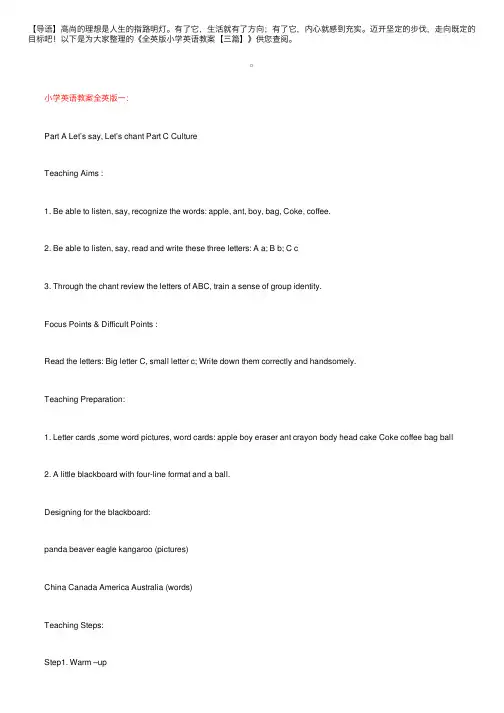
【导语】⾼尚的理想是⼈⽣的指路明灯。
有了它,⽣活就有了⽅向;有了它,内⼼就感到充实。
迈开坚定的步伐,⾛向既定的⽬标吧!以下是为⼤家整理的《全英版⼩学英语教案【三篇】》供您查阅。
⼩学英语教案全英版⼀: Part A Let’s say, Let’s chant Part C Culture Teaching Aims : 1. Be able to listen, say, recognize the words: apple, ant, boy, bag, Coke, coffee. 2. Be able to listen, say, read and write these three letters: A a; B b; C c 3. Through the chant review the letters of ABC, train a sense of group identity. Focus Points & Difficult Points : Read the letters: Big letter C, small letter c; Write down them correctly and handsomely. Teaching Preparation: 1. Letter cards ,some word pictures, word cards: apple boy eraser ant crayon body head cake Coke coffee bag ball 2. A little blackboard with four-line format and a ball. Designing for the blackboard: panda beaver eagle kangaroo (pictures) China Canada America Australia (words) Teaching Steps: Step1. Warm –up 1. Sing a song. 2. Free talk T: Hello. I’m Wendy. I’m from Hangzhou. S1: Hello! I’m ... I’m from Hangzhou,too. T: Nice to meet you. S: Nice to meet you, too. T: Let’s play. Ok? S: Great! T: Watch out! (T throws the ball.) S: Oh, no. Make a similar dialogue with your partner. Step2.Presentation. 1. 1)T : Today, we will learn letters. Do you know letters? Just as A,B,C…… They are letters. What’s the meaning of letters? S: 字母。
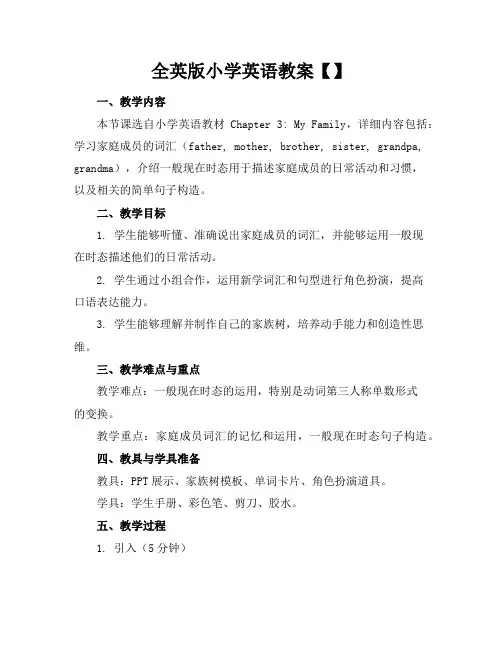
全英版小学英语教案【】一、教学内容本节课选自小学英语教材Chapter 3: My Family,详细内容包括:学习家庭成员的词汇(father, mother, brother, sister, grandpa, grandma),介绍一般现在时态用于描述家庭成员的日常活动和习惯,以及相关的简单句子构造。
二、教学目标1. 学生能够听懂、准确说出家庭成员的词汇,并能够运用一般现在时态描述他们的日常活动。
2. 学生通过小组合作,运用新学词汇和句型进行角色扮演,提高口语表达能力。
3. 学生能够理解并制作自己的家族树,培养动手能力和创造性思维。
三、教学难点与重点教学难点:一般现在时态的运用,特别是动词第三人称单数形式的变换。
教学重点:家庭成员词汇的记忆和运用,一般现在时态句子构造。
四、教具与学具准备教具:PPT展示、家族树模板、单词卡片、角色扮演道具。
学具:学生手册、彩色笔、剪刀、胶水。
五、教学过程1. 引入(5分钟)通过展示不同家庭的图片,引导学生用英语描述家庭成员,激活背景知识。
引导学生观察并尝试用英语说出家庭成员的日常活动。
2. 新课内容呈现(15分钟)利用PPT展示新词汇,配合动作和图片,帮助学生理解和记忆。
通过例句展示一般现在时态的用法,并引导学生模仿造句。
3. 互动练习(15分钟)分组进行单词接龙游戏,加强词汇记忆。
小组内进行角色扮演,用新学词汇和时态描述家庭成员的活动。
4. 巩固环节(10分钟)每组选取一个家庭成员,用一般现在时态在班上介绍其日常活动。
教师点评并纠正发音和语法错误。
5. 课堂实践(15分钟)学生根据模板制作自己的家族树,并在小组内分享。
教师巡回指导,帮助学生解决实际问题。
学生展示家族树作品,进行互相评价。
六、板书设计1. 板书上方:家庭成员词汇表2. 板书中央:一般现在时态句型结构3. 板书下方:家族树模板和示例七、作业设计1. 作业题目:制作一个关于自己家庭成员的海报,并运用一般现在时态描述他们的日常活动。
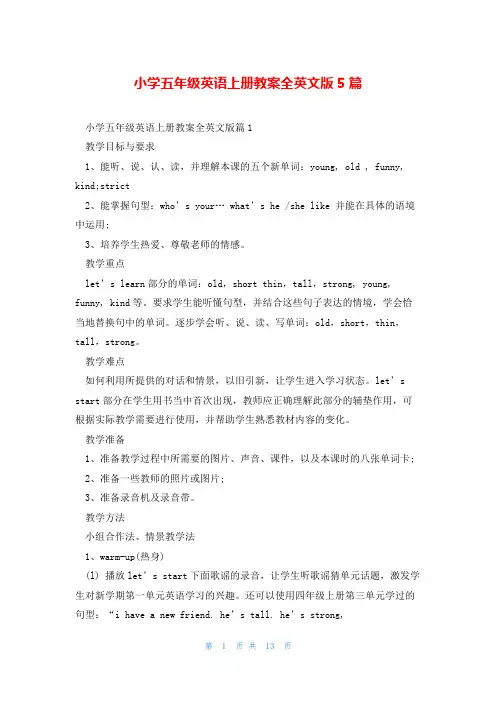
小学五年级英语上册教案全英文版5篇小学五年级英语上册教案全英文版篇1教学目标与要求1、能听、说、认、读,并理解本课的五个新单词:young, old , funny, kind;strict2、能掌握句型:who’s your… what’s he /she like 并能在具体的语境中运用;3、培养学生热爱、尊敬老师的情感。
教学重点let’s learn部分的单词:old,short thin,tall,strong, young, funny, kind等。
要求学生能听懂句型,并结合这些句子表达的情境,学会恰当地替换句中的单词。
逐步学会听、说、读、写单词:old,short,thin,tall,strong。
教学难点如何利用所提供的对话和情景,以旧引新,让学生进入学习状态。
let’s start部分在学生用书当中首次出现,教师应正确理解此部分的辅垫作用,可根据实际教学需要进行使用,并帮助学生熟悉教材内容的变化。
教学准备1、准备教学过程中所需要的图片、声音、课件,以及本课时的八张单词卡;2、准备一些教师的照片或图片;3、准备录音机及录音带。
教学方法小组合作法、情景教学法1、warm-up(热身)(l) 播放let’s start下面歌谣的录音,让学生听歌谣猜单元话题,激发学生对新学期第一单元英语学习的兴趣。
还可以使用四年级上册第三单元学过的句型:“i have a new friend. he’s tall. he’s strong,too.”并结合相关人物的图片,引导学生复习 strong, tall, short,thin等词,为本课时听、说、读、写这些单词做好准备。
(2)日常口语练习,内容可参考如下:t:hello, everyone! welcome back to school! nice to see you!ss: nice to meet you!(3) 问学生几个问题,引出本课重点内容。

三年级英语教案全英文英语教案设计是改善课堂教学的一种更高层次的探索,是提高课堂教学质量和效率的一项必要工作,它可以促进教学的系统化,使老师掌握讲课节奏。
下面是我给大家整理的三年级英语教案全英文5篇,希望对大家能有所帮助!三年级英语教案全英文1unit 3 touching and feeling(1)教学内容1. learners identify objects by touch2. learners categorize objects by feeling to complete a table3. learners play a game to guess what an object is by feeling and categorizing it4. learners should conclude that we feel with our hands教学目标:知识与技能:掌握祈使句和相关形容词的用法。
过程与方法:学会灵活的自编小对话。
情感、态度与价值:学会礼貌的待人接物。
教学重难点5. identifying objects by touch6. asking questions about and describing the way things feel7. identifying letters of the alphabet shapes8. responding to simple instructions9. saying the sound ‘e’ in its open syllable form教学准备cassette 3b and a cassette player, wall pictures, cushion, pineapple, apple教学过程教师活动学生活动教学意图pre-task preparation . revision1.put on the masks then play the game.2.what can you do introduce.3.show the pictures. what’s this/thatis this/that… what do you see1.words: soft, hard, rough, smooth1.t: what do you see p:i see some sweets.2..touch the sweets one by one then teach〞soft〞3.what is soft please tell me.4.touch the desk then teach “hard〞.5.the same way to teach “rough, smooth〞6.make a new rhyme.2 play the cassette again. students repeat.3 invite individual students to come to the desk. give them a thing to touch and feel. students have to close their eyes when they play the game.say: touch it. how does it feelto elicit: its ...ask: what is itto elicit: its at an ...ask the questions.用旧知引入新知识,新单词。
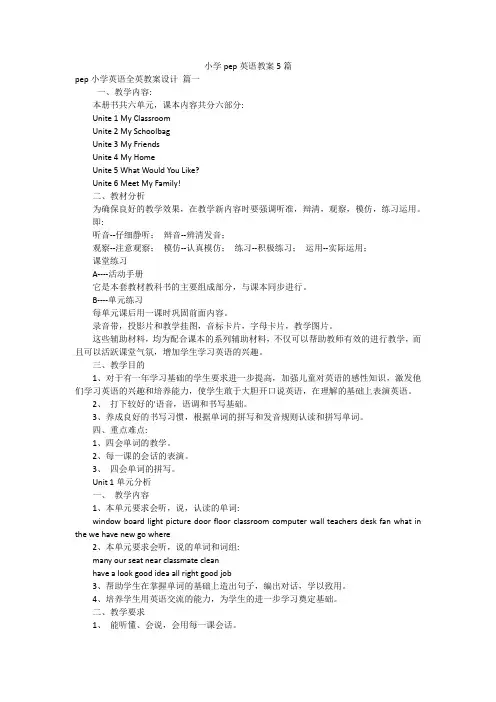
小学pep英语教案5篇pep小学英语全英教案设计篇一一、教学内容:本册书共六单元,课本内容共分六部分:Unite 1 My ClassroomUnite 2 My SchoolbagUnite 3 My FriendsUnite 4 My HomeUnite 5 What Would You Like?Unite 6 Meet My Family!二、教材分析为确保良好的教学效果,在教学新内容时要强调听准,辩清,观察,模仿,练习运用。
即:听音--仔细静听;辩音--辨清发音;观察--注意观察;模仿--认真模仿;练习--积极练习;运用--实际运用;课堂练习A----活动手册它是本套教材教科书的主要组成部分,与课本同步进行。
B----单元练习每单元课后用一课时巩固前面内容。
录音带,投影片和教学挂图,音标卡片,字母卡片,教学图片。
这些辅助材料,均为配合课本的系列辅助材料,不仅可以帮助教师有效的进行教学,而且可以活跃课堂气氛,增加学生学习英语的兴趣。
三、教学目的1、对于有一年学习基础的学生要求进一步提高,加强儿童对英语的感性知识,激发他们学习英语的兴趣和培养能力,使学生敢于大胆开口说英语,在理解的基础上表演英语。
2、打下较好的'语音,语调和书写基础。
3、养成良好的书写习惯,根据单词的拼写和发音规则认读和拼写单词。
四、重点难点:1、四会单词的教学。
2、每一课的会话的表演。
3、四会单词的拼写。
Unit 1单元分析一、教学内容1、本单元要求会听,说,认读的单词:window board light picture door floor classroom computer wall teachers desk fan what in the we have new go where2、本单元要求会听,说的单词和词组:many our seat near classmate cleanhave a look good idea all right good job3、帮助学生在掌握单词的基础上造出句子,编出对话,学以致用。
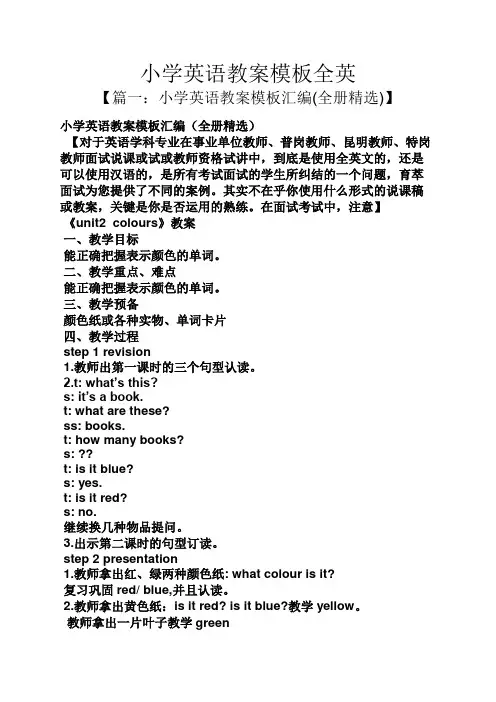
小学英语教案模板全英【篇一:小学英语教案模板汇编(全册精选)】小学英语教案模板汇编(全册精选)【对于英语学科专业在事业单位教师、普岗教师、昆明教师、特岗教师面试说课或试或教师资格试讲中,到底是使用全英文的,还是可以使用汉语的,是所有考试面试的学生所纠结的一个问题,育萃面试为您提供了不同的案例。
其实不在乎你使用什么形式的说课稿或教案,关键是你是否运用的熟练。
在面试考试中,注意】《unit2 colours》教案一、教学目标能正确把握表示颜色的单词。
二、教学重点、难点能正确把握表示颜色的单词。
三、教学预备颜色纸或各种实物、单词卡片四、教学过程step 1 revision1.教师出第一课时的三个句型认读。
2.t: what’s this?s: it’s a book.t: what are these?ss: books.t: how many books?s: ??t: is it blue?s: yes.t: is it red?s: no.继续换几种物品提问。
3.出示第二课时的句型订读。
step 2 presentation1.教师拿出红、绿两种颜色纸: what colour is it?复习巩固red/ blue,并且认读。
2.教师拿出黄色纸:is it red? is it blue?教学yellow。
教师拿出一片叶子教学green教师拿出一个自制的红绿灯教学一首小诗:red, red stop;yellow yellow wait;green green go go go!3. t show an orange: what’s this ? it’s an orange. what colour is it? it’s orange.t: orange is orange.4.show a peach:what colour is it? it’s pink.教学粉红色。
5. show a chocolate: what colour is it? it’s brown.教学棕色。
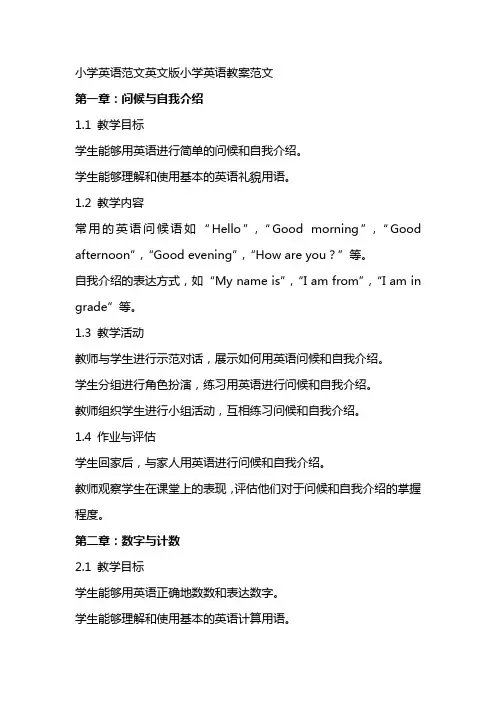
小学英语范文英文版小学英语教案范文第一章:问候与自我介绍1.1 教学目标学生能够用英语进行简单的问候和自我介绍。
学生能够理解和使用基本的英语礼貌用语。
1.2 教学内容常用的英语问候语如“Hello”,“Good morning”,“Good afternoon”,“Good evening”,“How are you?”等。
自我介绍的表达方式,如“My name is”,“I am from”,“I am in grade”等。
1.3 教学活动教师与学生进行示范对话,展示如何用英语问候和自我介绍。
学生分组进行角色扮演,练习用英语进行问候和自我介绍。
教师组织学生进行小组活动,互相练习问候和自我介绍。
1.4 作业与评估学生回家后,与家人用英语进行问候和自我介绍。
教师观察学生在课堂上的表现,评估他们对于问候和自我介绍的掌握程度。
第二章:数字与计数2.1 教学目标学生能够用英语正确地数数和表达数字。
学生能够理解和使用基本的英语计算用语。
2.2 教学内容数字0到10的读写和表达方式。
基本的加减法运算的表达方式,如“+”,“-”,“=”等。
2.3 教学活动教师教授数字0到10的读写和表达方式,并进行示范。
学生进行数数练习,从0数到10。
学生进行简单的加减法运算练习,如1+1,2-1等。
2.4 作业与评估学生回家后,练习数数和简单的加减法运算。
教师观察学生在课堂上的表现,评估他们对于数字和计数的掌握程度。
第三章:颜色3.1 教学目标学生能够用英语正确地表达各种颜色。
学生能够理解和使用基本的英语颜色词汇。
3.2 教学内容常用的英语颜色词汇,如“red”,“blue”,“green”,“yellow”,“black”,“white”等。
3.3 教学活动教师教授颜色词汇,并进行示范。
学生在教师的指导下,进行颜色认知和表达的练习。
学生分组进行颜色配对游戏,提高颜色词汇的应用能力。
3.4 作业与评估学生回家后,练习表达颜色词汇。
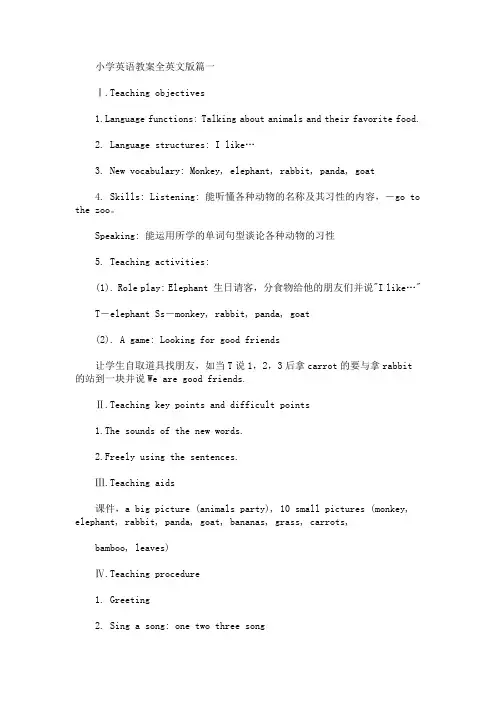
小学英语教案全英文版篇一Ⅰ.Teaching objectivesnguage functions: Talking about animals and their favorite food.2. Language structures: I like…3. New vocabulary: Monkey, elephant, rabbit, panda, goat4. Skills: Listening: 能听懂各种动物的名称及其习性的内容,-go to the zoo。
Speaking: 能运用所学的单词句型谈论各种动物的习性5. Teaching activities:(1). Role play: Elephant 生日请客,分食物给他的朋友们并说"I like…"T-elephant Ss-monkey, rabbit, panda, goat(2). A game: Looking for good friends让学生自取道具找朋友,如当T说1,2,3后拿carrot的要与拿rabbit的站到一块并说We are good friends.Ⅱ.Teaching key points and difficult points1.The sounds of the new words.2.Freely using the sentences.Ⅲ.Teaching aids课件,a big picture (animals party), 10 small pictures (monkey, elephant, rabbit, panda, goat, bananas, grass, carrots,bamboo, leaves)Ⅳ.Teaching procedure1. Greeting2. Sing a song: one two three song3. say goodbye to the 1, 2, 3 and go to the zooT: We are going to the zoo today. Therere many animals at the zoo.T introduces animals by action and sound, show animals pictures and put them on the big picture, and teachtheir names. ( 使用课件Part 1 )4. Review food names and teach " I like…" (使用课件Part 2 )(1). T act as the elephant, tell Ss "today is my birthday, I have food and Ill give them to my friends "( T showsfood pictures and Ss review)(2).role play:T act as the elephant first and teach " I like…", and then find my friends( Ss) to play and practice the sentences.5. CA: T shows pictures, Ss practice the sentences6. PA: Ss use their food to practice the sentences7. A game: Looking for good friends( moral education: We are friends, we should take good care of each other.)(1). 先找S1配合示范: T在B上找到monkey的图片, S1找到bananas的图片, T and Ss say " were good friends", ask Ss to play.(2). 对对碰:Let 10Ss hold 10 pictures, when T say 1, 2, 3 , Ss should find their friends at once.8. Sing a song: two little black birds ( 使用课件Part 3 )9. Sum up (使用课件Part 1 and 2 )小学英语教案全英文版篇二Teaching objectives:1.It looks like ____.2.cloud , sky3.lie.Danny goes to the park, we should clear about its meaning. It’s fun and happy, if you have time you can go out to play after you have finished your words.The nature is clear and vivid, clean air, green trees and leaves, white clouds, beautiful flowers. We can go out share it.Teaching focal points:1.how to use “look like”2.lieTeaching difficulty points:1.how to use “look like”2.lieTeaching aims:A tapeA big picture of the dialogueTeaching steps:Class opening and reviewReview “flowers” “leaves” “grass” with a drill. Choose a drill from “Teaching Techniques”IntroduceDemonstrate “cloud” and “sky” with your poster, or by pointing out the window of your classroom.Draw quick pictures of clouds on the blackboard.Make the clouds look like something. Say phrases such as:Use a puppet to introduce the word “lie” For example, draw quick pictures of a bed and some grass on the blackboard. Make the pu ppet “lie” on these as you say phrases for it such as:I am tired. I want to sleep.Where can I sleep?Here’s a bed. I am going to lie on the bed.Now I am lying on the bed.I don’t want to sleep here!Here’s some grass.Now I am lying on the grass.Now I can see the sky!PracticeDivide the class into small groups. Ask each group to make up a dialogue about lying on the grass and looking at clouds in the sky. Please read about making up dialogues in “Teaching Techniques”Pl ay “Go Fish” or “Memory Card” with the students’ flashcards for the following words: cloud, sky, flowers, leaves, grass, snow, ice, rain, sun and wind.Use the activity bookNumber 2 in the activity book is a listening exercise on the audiotape as follows:Listen, draw the shapes and write the words.a triangleb. linec. circled. squareBlackboard show:Lesson19:Let’s go to the park lie on cloud skyIt looks like _________ .。

小学英语全英教案【通用6篇】(经典版)编制人:__________________审核人:__________________审批人:__________________编制单位:__________________编制时间:____年____月____日序言下载提示:该文档是本店铺精心编制而成的,希望大家下载后,能够帮助大家解决实际问题。
文档下载后可定制修改,请根据实际需要进行调整和使用,谢谢!并且,本店铺为大家提供各种类型的经典范文,如总结报告、演讲发言、规章制度、员工手册、创业计划、企划方案、心得体会、法律文书、教学资料、其他范文等等,想了解不同范文格式和写法,敬请关注!Download tips: This document is carefully compiled by this editor. I hope that after you download it, it can help you solve practical problems. The document can be customized and modified after downloading, please adjust and use it according to actual needs, thank you!Moreover, our store provides various types of classic sample texts, such as summary reports, speeches, rules and regulations, employee manuals, entrepreneurial plans, planning plans, insights, legal documents, teaching materials, other sample texts, etc. If you want to learn about different sample formats and writing methods, please pay attention!小学英语全英教案【通用6篇】小学英语全英教案篇一Section CCould you give us some advice on how to learn English well? 公安县自强初级中学杜亚兰Ⅰ.Material analysis 本课是九年级第三单元第三话题的第三课时。
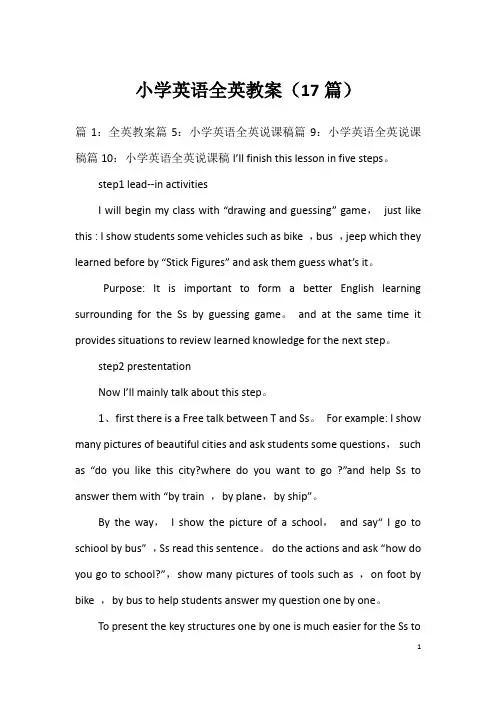
小学英语全英教案(17篇)篇1:全英教案篇5:小学英语全英说课稿篇9:小学英语全英说课稿篇10:小学英语全英说课稿I’ll finish this lesson in five steps。
step1 lead--in activitiesI will begin my class with “drawing and guessing” game,just like this : I show students some vehicles such as bike ,bus ,jeep which they learned before by “Stick Figures” and ask them guess what’s it。
Purpose: It is important to form a better English learning surrounding for the Ss by guessing game。
and at the same time it provides situations to review learned knowledge for the next step。
step2 prestentationNow I’ll mainly talk about this step。
1、first there is a Free talk between T and Ss。
For example: I show many pictures of beautiful cities and ask students some questions,such as “do you like this city?where do you want to go ?”and help Ss to answer them with “by train ,by plane,by ship”。
小学英语教学目标全英教案模板(共3篇)第1篇:小学英语全英教案小学英语全英教案范文【篇1:全英文英语教案模板】leon plannsefc module2 unit reading in teacher: period:period1 type:reading duration: 45minutes teaching ideologythe current theory view reading as a interactive proce which involves not only the printed page but also the reader’s old knowledge of the language in general, the world and the text types.in the reading proce, these factors interact with each other and compensate for each other.based on the understanding of reading as an interactive proce, teaching reading in the claroom is divided into three stages in which the top-down and bottom-up techniques integrated to develop the students language efficiency in general and reading strategies.the three stages are pre-reading, while-reading and post-reading.teaching material and learning condition the analysis of teaching material the teaching material is the reading part from nsefc module2 unit.the topic of this unit is.this paage mainly introduces the paage consists of paragraphs.the first paragraph is a general introduction of the.para.2 to para.4 introduces.the last paragraph tells about.the topic is not new to the.but there is some new words and phases in the paage.the analysis of learning condition the students are from grade1 in senior high school.as high school students, they have achieved certain english level and they have the ability to get the basic idea of the reading.since they are in grade1, they are easily activated and want to air their own opinions on the topic.they are familiar with the topic of andknow some.but they may not know before.moreover, their vocabulary is limited so they may have difficulties in understanding some sentences.learning objectives nguage skills ? at the beginning of the cla, can predict the content of the paage based on the title.? can scan the paage and find out the specific information such as the person related withcan summarize the paage with the help of the clues of the nguage knowledgecan master the key words and phrases of the paage as follows,.? can learn , especially 3.affectswill realize that and they will concern themselves with the iue of4.cultural awarenewill broaden their minds by knowing something about 5.learning strategieswill cultivate their ability individual learning and cooperative learning by doing someactivities independently and some in groups.? will communicate with each other in english while doing the group nguage difficultiesfocuses and anticipated language focusesthis is a reading period so the focus is to cultivate the students’ reading skills.the many activities are designed to help to train their reading skills, such as predicting, skimming, scanning and summarizing.it is also important for the to master the new words and phrases.anticipated difficultiesas the have a limited vocabulary, so they may have some difficulties in understanding the paage.so the teacher will help them learn the new words and phrases.may did not heard before, so the teacher will tell them some background knowledge aboutit.teaching methodthree-stage model: based on the understanding of reading as an interactive proce, teaching reading in the claroom is divided into three stages in which the top-down and bottom-up techniques integrated to develop the students language efficiency in general and reading strategies.the three stages are pre-reading, while-reading and post-reading.teaching aids multimedia devices and ppt documents: in order to help to fully understand the whole paage, i adopt multimedia devices and ppt documents to bring the real-life situation into the claroom.teaching procedures step1.lead-in(6min)activity1.greetings and free-talking(2min)t leads into the topic by asking some they know.tell the name of the they know freely.t: hello boys and girls.(say hello to the teacher.)t: when we say , what appears in your minds?(tell the things appear in their minds freely.)t: what are the ?(tell some names of.) activity2.picture-talking(4min)t shows some pictures about the in china and abroad.after seeing the pictures, are expected to tell the similarities of them.t: just now, you talk about some in china.now, let’s see some pictures of some.(t shows the pictures and see them carefully.) t: what do the have in common?for example, they are very precious.what are your opinions?(t gives them some hints and tell the characteristics of)[aims] in this step, t first leads in the topic by talking with the freely about the whichis familiar to them and then see some pictures and tell the characteristics.these two activities aim to arouse the ’ interests in the topic and activate their old knowledge of.then will bementally prepared for the reading comprehension.what’s more,when they are talking about the charateristics of, they will realize that theare rare and precious and they will concern themselves with the iue of.step2.pre-reading(3min)activity1.knowing something about(1min)t gives a brief introduction of the.will know the t: today, we are going to learn.it is.do you know what is?(t shows some pictures ofand get to know the.)activity2.predicting(2min)t asks to read the title of the paage and then ask them some questions.will predict the content of the paage with the help of the title.t: please look at the ti tle “”, what does “” mean?(if the can not give the answer, then t explain it.)t: in search means that people are looking for it.why are people looking for it? can you gue? what will the paage talk about?(predict the content, but t will not give the answer here.)[aims] in this step, the first know some information of the;the background information will make it easier for the to understand the paage.then t asks to make predictions about the paage.it aims to help develop the reading skills of predicting.step3.while-reading(22min)activity1.skimming(4min)skim the whole paage and find out and check their predictions.t: why are people still ? here is a multiple choice for you.activity2.scanning(3min)t presents several true or false statements and asks the to scan the paage and judge the right from the wrong.(keys: F,F,T,T,F)activity3 close-reading(15min)t designs various kinds of activities and do the activities to fully understand the paage.para.1t: please read para.1 carefully and then take some note aboutthe.para.2-4please read para.2-4 carefully and then find out the removal of the room.please read para.2-4 carefully and then find out the person related with the amber room and the things them down with it.para.5 please read para.5 carefully and then find out the the rebuilding of the amber room.【篇2:pep小学英语全英教案模板】the english teaching plan of pep book 4enhe primary school teacher:___________ the curriculum schedule cla:____________ cla:____________ the teaching schedule the students’ result tablethe english curriculum standard英语课程标准一级目标总体目标:对英语有好奇心,喜欢听他人说英语;能根据教师的简单指令做游戏、做动作、做事情(如涂颜色、连线);能做简单的角色扮演;能唱简单的英文歌曲,说简单的英语歌谣;能在图片的帮助下听懂和读懂简单的小故事;能交流简单的个人信息,表达简单的情感和感觉;能书写字母和单词;对英语学习中接触的外国文化习俗感兴趣。
小学英语教学设计全英小学英语教学设计一等奖汇总(5篇)小学英语教学设计全英小学英语教学设计一等奖篇一一、英语unit 1《e with me》教学设计一、教学目标:1、认识目标: is this your dictionary? no,it's 'stony's does she do? she's a doctor.2、能力目标:listen and look3、情感目标:鼓励学生大胆开口说英语,用英语打招呼二、教学内容:listen and look三、教学重难点:重难点是句型的综合运用。
四、课前准备:录音机单词卡挂图五、教学过程:1、listen and sing.“what do you want to do?”2、ask and answer:--what's his name?(point to gogo)--his name's gogo.--can he fly?--yes,he can.--can he use magic?--yes,he can.3、让学生观看vcd,跟读,并把句子板书出来,学生认读。
--where are you going?--i'm going to an island.--we can't fly.--e withme./let's go.4、师生操练、生生操练句型。
5、呈现listen and look,要求学生把听到的句子说出来。
6、pair work and act.7、point and say.8、homework(1)把课文读给家长听。
(2)表演与同学的对话,用英语问候老师和同学。
六、板书设计: unit one e with me--where are you going?--i'm going to an island.--we can't fly.--e with me./let's go.七、教学反思:小部分学生比较难上口,需要反复读说。
小学英语全英说课稿(10篇)温馨提示:本文是笔者精心整理编制而成,有很强的的实用性和参考性,下载完成后可以直接编辑,并根据自己的需求进行修改套用。
小学英语全英说课稿第1篇:Part One Analysis of the Teaching Material(一) STATUS AND FUNCTION1。
This is an important lesson in Book One。
From this lesson, it starts asking the Ss to grasp contents of each Sample。
To attain four skills request of listening, speaking, reading and writing。
To start listing Word Bank and tell the Ss to remember the new words。
To start asking the Ss to write the English sentences well。
Therefore this lesson is in the important position of the teaching material。
2。
This lesson is the first one of Unit 2。
So if the Ss can learn it well, it will be helpful to make the Ss learn the rest of this unit。
3。
Such a topic is related to daily life, so it is helpful to raise learning interests of students and it will be also helpful to improve their spoken English。
小学英语全英文教案小学英语全英文教案「篇一」Theme: DiscussionFunction: Presenting different points of view。
Target Language: What do you suggest? What about ? Why don't you ? How about?I think so. I don't think so。
Vocabulary: suggest, quickly, excited, America, Chinese, kind, dragon, same, circlePronunciation: / / / / / / / /Poem: Do you agree?一、Warmer:1. Draw some pictures to help the Ss to learn the words: some chopsticks, a dragon, a kite, a radio, a CD2. Put the pictures on the board, then the teacher call out the names of the pictures and let the Ss point them。
二、Presentation:1. Look, listen and learn:A. Tell the Ss that you are going to play a dialogue. The Ss have to listen and tell you what things they are thinking of giving to the cousin。
B. They have to listen to the objects that are suggested in the text。
C. Tell the Ss to close their books. Play the dialogue and get the Ss to listen and note down their answers. Then ask them what objects they heard were mentioned。
【导语】教育者有⽬的有计划有组织的对受教育者的⾝⼼发展进⾏教化培育,以现有的经验、学识推敲于⼈,为其解释各种现象、问题或⾏为,以增长能⼒经验。
以下是为⼤家整理的《⼩学英语教案全英⽂版【三篇】》供您查阅。
【篇⼀】TEACHING PROCEDURESI、Warming-upStep one:Let’s the student listen to the tape.And review some adj. about weather.Eg:warm,cool,hot,cold.Let the students do actions while listening.Step two:Do an exercise.The teacher will ask some questions about the listen test.It's about part B read and write in grade five.Eg:What's your favourite (II)previewStep one:ask and answerThe teacher is going to ask some questions. (eg:what is the weather like?)And show off the different pictures about weather. Guide students to answer questions by using warm,cool,hot.III、PresentationLet's learnStep one:words studyDraw a trunk on the blackboard,and then add some light green leaves.Ask students(look!The leaves are green now.What season is it now?) Show off the word card "season".Teach them "season".After that,show off "spring".Students read after the teacher.And describe the weather of "spring" character depend on their owe life.(eg:spring is warm in hangzhou/taiwan.) Then point at the main city on the map,and ask what is the weather like in beijing/shenzhen? Spell together.Step two:continute to add deep green leaves on the tree.And say look!The leaves are becoming more and more.Summer is coming.Teach "summer"in the same way.Step three:draw the sun and ligth,and acquit very hot.Ask oh,what is the weather like in summer?Guide students to answer it. It's hot,very very hot.Step four:clean parts of leaves and light,and then colour some leaves into yellow.Ask look!Now it's cool.What season is it now?Oh.It's fall now.Writing "fall" on the board.Spell together.Step five:clean parts of leaves,and then add some cloudy and snow.Say"now,the weather is very cold.It is winter now.".Teach "winter".Ask and answer:"what is the weather like in winter in ……?"Step six:show off different picture about weather,and ask and answer.Eg:T:What's the weather like?S:It's windy.T:What season is it now?S:Spring.ect.Continu to ask a question"what's your favourite season?"Guide students to answer it.Let's startStep one:show off different picture about seasons.Ask"what's the weather like in this picture?"Step two:Play a gameTeacher shows the picture in different seasons.In order to see who can correctly say the first word, the winners must give incentives.Step three:Guide students to use patterns of small groups. And finish let's start .(eg:what's your favourite season?……because it's ……)Consolidation and extensionLet student do some exercise which is from student exercise book.【篇⼆】After some practice by asking and answering, I present the next language points:There’s no …inon ear…Have …then.And I will stick these sentence patterns on the Bb. Finally I’ll let the Ss do pair works to consolidate them.Step 3 Listen to the tape and Ss imitate to read and say.As the new reformation of curriculum, emphasized the traditional class attach importance to the mechanical teaching, neglect the experience and participation, for example, the five-step method. So in this lesson, after presentation, I ask Ss to listen to the tape with three Qs, read in different roles and in pairs, then try to recite the text.Step 4 Ss be the main body, T makes a guider.In class, Ss play as a host, and the T makes an influence on guiding, help Ss to act the learnt dialogue, it can stress the position of the Ss, and arouse their interest.Then I show a carton with no voice, ask Ss to make a dialogue in pairs.There are lots of ways to consolidate the new knowledge. Playing game is a good way. So according to the physiology of Ss, I hold a group competition during the game, ask Ss to finish the blanks. In this way can develop Ss’ good habits and achieve the aim of mastering the learned knowledge in situation.Step 5 Change class to life, learn by themselves.Is this the end of the class? I don’t think so. If there is an end, I think it should be in the life. So I extend this class, encourage Ss to use the learned to communicate with each other in their life.In a word, the whole period is based on tasks, which are designed from easy steps to steps that are challenging. When the Ss are carting out the tasks, they can acquire information, knowledge, and have their ability and skills trained.That’s all. Thanks a lot for your attention.【篇三】Part A Let’s say, Let’s chant Part C CultureTeaching Aims :1. Be able to listen, say, recognize the words: apple, ant, boy, bag, Coke, coffee.2. Be able to listen, say, read and write these three letters: A a; B b; C c3. Through the chant review the letters of ABC, train a sense of group identity.Focus Points & Difficult Points :Read the letters: Big letter C, small letter c; Write down them correctly and handsomely.Teaching Preparation:1. Letter cards ,some word pictures, word cards: apple boy eraser ant crayon body head cake Coke coffee bag ball2. A little blackboard with four-line format and a ball.Designing for the blackboard:panda beaver eagle kangaroo (pictures)China Canada America Australia (words)Teaching Steps:Step1. Warm –up1. Sing a song.2. Free talkT: Hello. I’m Wendy. I’m from Hangzhou.S1: Hello! I’m ... I’m from Hangzhou,too.T: Nice to meet you.S: Nice to meet you, too.T: Let’s play. Ok?S: Great!T: Watch out! (T throws the ball.)S: Oh, no.Make a similar dialogue with yourpartner.Step2.Presentation.1. 1)T : Today, we will learn letters. Do you know letters? Just as A,B,C…… They are letters. What’s the meaning of letters?S: 字母。
【导语】抓住今天吧!紧紧地把它抓住吧!今天的分分秒秒,都要有所作为,有所进步,有所登攀!以下是®⽆忧考⽹为⼤家整理的《⼩学英语教案设计【三篇】》供您查阅。
【篇⼀】教学内容: Unit 12 I can swim Lesson Four 教学⽬标: 1、Vocabulary: Understand listening and saying the words :x-ray , yo-yo, zebra, zoo. 2、Structures. What is it? It’s a (yo-yo,). 教学⽬标的检测途径 1.根据⽼师的提⽰,指出相应的图⽚2.阅读反馈. 重点难点: 1、Learn the words and say the rhyme. 2、Make the dialogue. 突破教学难点的⽅法个别学⽣混淆可能会net与 nest读⾳和意思,加强两者在因、形、意上的⽐较。
结合他们的观察进⾏提问。
教具准备: 图⽚ PPT 教学过程: ⼀、Warm-up 1、Sing the Animal song together. 2、Greetings. T: Hello, good morning, boys and girls. Ss: Hello, good morning, Miss Liu . T: Nice to meet you. Ss: Nice to meet you. 3、Review the names of animals. Respond to with the correct animal movement or imitation. What’s this? Ss:It’s dog, fish, cat, bird, lion, tiger, panda, rabbit, monkey. 4.T: What can the elephant do? T: It’s can walk. Walk, walk, an elephant can walk. ( do action) T: Can you walk? S: Yes, I can. 阅读反馈:让学⽣在⿊板上找出该动作的单词。
全英版小学英语教案【三篇】小学英语教案全英版一:Part A Let’s say, Let’s chant Part C CultureTeaching Aims :1. Be able to listen, say, recognize the words: apple, ant, boy, bag, Coke, coffee.2. Be able to listen, say, read and write these threeletters: A a; B b; C c3. Through the chant review the letters of ABC, train asense of group identity.Focus Points & Difficult Points :Read the letters: Big letter C, small letter c; Writedown them correctly and handsomely.Teaching Preparation:1. Letter cards ,some word pictures, word cards: apple boy eraser ant crayon body head cake Coke coffee bag ball2. A little blackboard with four-line format and a ball.Designing for the blackboard:panda beaver eagle kangaroo (pictures)China Canada America Australia (words)Teaching Steps:Step1. Warm –up1. Sing a song.2. Free talkT: Hello. I’m Wendy. I’m from Hangzhou.S1: Hello! I’m ... I’m from Hangzhou,too.T: Nice to meet you.S: Nice to meet you, too.T: Let’s play. Ok?S: Great!T: Watch out! (T throws the ball.)S: Oh, no.Make a similar dialogue with your partner.Step2.Presentation.1. 1)T : Today, we will learn letters. Do you know letters? Just as A,B,C…… They are letters. What’s the meaning of letters?S:字母。
T: Great! A is the first letter. ( T shows letter A.)T: A a↗↘ S: A a↗↘T: This is big letter A. 大写字母A。
T: Big letter A. S: Big letter A.T: Let’s make a big letter A. (With the hands)Run two trains: Big letter A. (With the hands)T: This is small letter a.T: Small letter A S: Small letter A.T: Look at this girl’s head. It’s a smallletter a.小a, 小a, 小翘辫。
Run two trains: Big letter A, small letter a.2). T draws an apple: What’s this?S: It’s an apple.T draws an ant beside the apple: What’s this?S: It’s an ant.T: A for ant, / /,/ /, / /.A for apple, / /, / /, / /.2. Teach B b, C c like above.Pay attention to the pronunciation of c.Use right hand to make a c.B for boy, /b/,/b/,/b/.B for bag, /b/,/b/,/b/.C for Coke, /k/,/k/,/k/.C for coffee, /k/,/k/,/k/.Step 3. Practise.1. Game: Find out the letters we’ve just learned.apple boy eraser ant crayon body head cake Coke coffeebagballRead as: apple, No.1 small letter a.2.1) T: You’re so smart. You can read them. Now, let’s write them down.Look at the blackboard.T: First, let’s write down big letter A. One, two, three. Now, Let’s try together. Show me your finger.S: My finger.T& Ss: One, two, three.T teaches the writing of small letter a.2) T: Everyone has his home. Where is A’s home?Here it is. (T points at the four-line format.)小学英语教案全英版二:TEACHING PROCEDURESI、Warming-upStep one:Let’s the student listen to the tape.And review some adj. about weather.Eg:warm,cool,hot,cold.Let the students do actions while listening.Step two:Do an exercise.The teacher will ask some questions about the listen test.It's about part B read andwrite in grade five.Eg:What's yo ur favourite ……?II、previewStep one:ask and answerThe teacher is going to ask some questions. (eg:what is the weather like?)And show off the different pictures aboutweather. Guide students to answer questions by usingwarm,cool,hot.III、PresentationLet's learnStep one:words studyDraw a trunk on the blackboard,and then add some lightgreen leaves.Ask students(look!The leaves are green now.What season is it now?) Show off the word card "season".Teach them "season".After that,show off "spring".Students read after theteacher.And describe the weather of "spring" character dependon their owe life.(eg:spring is warm in hangzhou/taiwan.)Then point at the main city on the map,and ask what is theweather like in beijing/shenzhen? Spell together.Step two:continute to add deep green leaves on thetree.And say look!The leaves are becoming more andmore.Summer is coming.Teach "summer"in the same way.Step three:draw the sun and ligth,and acquit veryhot.Ask oh,what is the weather like in summer?Guide studentsto answer it. It's hot,very very hot.Step four:clean parts of leaves and light,and thencolour some leaves into yellow.Ask look!Now it's cool.Whatseason is it now?Oh.It's fall now.Writing "fall" on theboard.Spell together.Step five:clean parts of leaves,and then add somecloudy and snow.Say"now,the weather is very cold.It is winternow.".Teach "winter".Ask and answer:"what is the weatherlike in winter in ……?"Step six:show off different picture about weather,andask and answer.Eg:T:What's the weather like?S:It's windy.T:What season is it now?S:Spring.ect.Continu to ask aquestion"what's your favourite season?"Guide students toanswer it.Let's startStep one:show off different picture aboutseasons.Ask"what's the weather like in this picture?"Step two:Play a gameTeacher shows the picture in different seasons.In orderto see who can correctly say the first word, the winners mustgive incentives.Step three:Guide students to use patterns of smallgroups. And finish let's start .(eg:what's your favourite season?……because it's ……)Consolidation and extensionLet student do some exercise which is from studentexercise book.小学英语教案全英版三:After some practice by asking and answering, I present the next language points:There’s no …inon ear…Have …then.And I will stick these sentence patterns on the Bb. Finally I’ll let the Ss do pair works to consolidate them.Step 3 Listen to the tape and Ss imitate to read and say.As the new reformation of curriculum, emphasized the traditional class attach importance to the mechanical teaching, neglect the experience and participation, for example, the five-step method. So in this lesson, after presentation, I ask Ss to listen to the tape with three Qs,read in different roles and in pairs, then try to recite thetext.Step 4 Ss be the main body, T makes a guider.In class, Ss play as a host, and the T makes an influence on guiding, help Ss to act the learnt dialogue, itcan stress the position of the Ss, and arouse their interest.Then I show a carton with no voice, ask Ss to make a dialogue in pairs.There are lots of ways to consolidate the new knowledge. Playing game is a good way. So according to the physiology of Ss, I hold a group competition during the game, ask Ss to finish the blanks. In this way can develop Ss’ goodhabits and achieve the aim of mastering the learned knowledge in situation.Step 5 Change class to life, learn by themselves.Is this the end of the class? I don’t think so. If there is an end, I think it should be in the life. So Iextend this class, encourage Ss to use the learned to communicate with each other in their life.In a word, the whole period is based on tasks, which are designed from easy steps to steps that are challenging. When the Ss are carting out the tasks, they can acquire information, knowledge, and have their ability and skills trained.That’s all. Thanks a lot for your attention.。